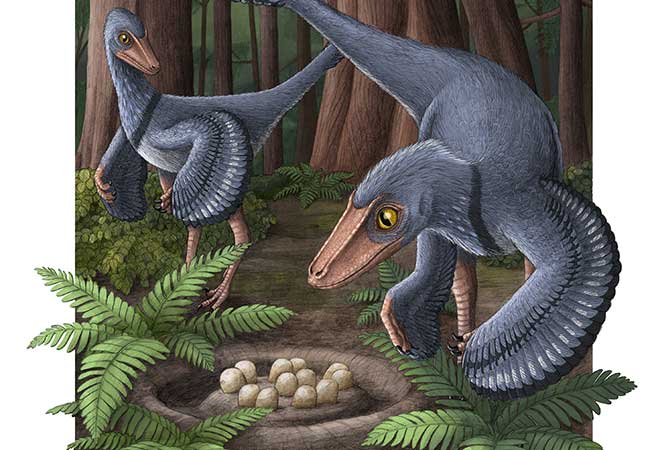An international research team led by Goethe University Frankfurt, Germany, determined that Troodon, a dinosaur very close to modern birds, was a warm-blooded animal (an endotherm), but had a reproductive system similar to that of modern reptiles. The scientists applied a new method which allowed for accurate determination of the temperature when the egg’s carbonate shell was formed. Furthermore, the researchers showed that Troodon laid 4 to 6 eggs per clutch. As nests with up to 24 Troodon eggs had been found, the scientists conclude that several Troodon females laid their eggs in communal nests.

In millions of years and with a long sequence of small changes, evolution has shaped a particular group of dinosaurs, the theropods, into the birds we watch fly around the planet today. In fact, birds are the only descendants of dinosaurs which survived the catastrophic extinction 66 million years ago that ended the Cretaceous period.
Troodon was such a theropod. The carnivorous dinosaur was about two meters long and populated the vast semi-arid landscapes of North America about 75 million years ago. Like some of its dinosaur relatives, Troodon presented some bird-like features like hollow and light bones. Troodon walked on two legs and had fully developed feathery wings, but its relatively large size precluded it from flying. Instead, it probably ran quite fast and caught its prey using its strong claws. Troodon females laid eggs more similar to the asymmetric eggs of modern birds than to round ones of reptiles, the oldest relatives of all dinosaurs. These eggs were coloured and have been found half buried into the ground, probably allowing Troodon to sit and brood them.
An international team of scientists led by Mattia Tagliavento and Jens Fiebig from Goethe University Frankfurt, Germany, has now examined the calcium carbonate of some well-preserved Troodon eggshells. The researchers used a method developed by Fiebig’s group in 2019 called “dual clumped isotope thermometry”. By using this method, they could measure the extent to which heavier varieties (isotopes) of oxygen and carbon clump together in carbonate minerals. The prevalence of isotopic clumping, which is temperature-dependent, made it possible for scientists to determine the temperature at which the carbonates crystallized.
When analyzing Troodon eggshells, the research team was able to determine that the eggshells were produced at temperatures of 42 and 30 degrees Celsius. Mattia Tagliavento, leading author of the study, explains: “The isotopic composition of Troodon eggshells provides evidence that these extinct animals had a body temperature of 42°C, and that they were able to reduce it to about 30°C, like modern birds.”
The scientists then compared isotopic compositions of eggshells of reptiles (crocodile, alligator, and various species of turtle) and modern birds (chicken, sparrow, wren, emu, kiwi, cassowary and ostrich) to understand if Troodon was closer to either birds or reptiles. They revealed two different isotopic patterns: reptile eggshells have isotopic compositions matching the temperature of the surrounding environment. This is in line with these animals being cold-blooded and forming their eggs slowly. Birds, however, leave a recognizable so-called non-thermal signature in the isotopic composition, which indicates that eggshell formation happens very fast. Tagliavento: “We think this very high production rate is connected to the fact that birds, unlike reptiles, have a single ovary. Since they can produce just one egg at the time, birds have to do it more rapidly.”
When comparing these results to Troodon eggshells, the researchers did not detect the isotopic composition which is typical for birds. Tagliavento is convinced: “This demonstrates that Troodon formed its eggs in a way more comparable to modern reptiles, and it implies that its reproductive system was still constituted of two ovaries.”
The researchers finally combined their results with existing information concerning body and eggshell weight, deducing that Troodon produced only 4 to 6 eggs per reproductive phase. “This observation is particularly interesting because Troodon nests are usually large, containing up to 24 eggs”, Tagliavento explains. “We think this is a strong suggestion that Troodon females laid their eggs in communal nests, a behaviour that we observe today among modern ostriches.”
These are extremely exciting findings, Jens Fiebig comments: “Originally, we developed the dual clumped isotope method to accurately reconstruct Earth’s surface temperatures of past geological eras. This study demonstrates that our method is not limited to temperature reconstruction, it also presents the opportunity to study how carbonate biomineralization evolved throughout Earth’s history.”
Publication: Mattia Tagliavento, Amelia J. Davies, Miguel Bernecker, Philip T. Staudigel, Robin R. Dawson, Martin Dietzel, Katja Goetschl, Weifu Guo, Anne S. Schulp, François Therrien, Darla K. Zelenitsky, Axel Gerdes, Wolfgang Müller, Jens Fiebig: Evidence for heterothermic endothermy and reptile-like eggshell mineralization in Troodon, a non-avian maniraptoran theropod. PNAS (2023) https://www.pnas.org/cgi/doi/10.1073/pnas.2213987120
Background:
Thermometers for Earth history: „Dual clumped isotope“ method for carbonate analysis (2020).








